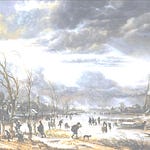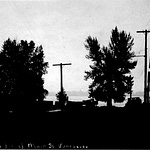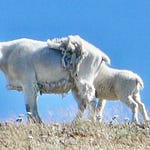Today, I’d like to highlight a local favorite of mine: the Red-winged Blackbird - Agelaius phoeniceus.
First Name: Red-winged would be a wonderful description, if it were correct. The problem, at least in regard to reality, is that red only applies to the bird’s shoulder patches. An older, first name used to be red-shouldered but apparently those who name birds eschewed the logic and decided to exaggerate the spread of red.
Surname: Blackbird is also apt, as the birds are all black. At least the males are. Recently, bird names have become controversial because of the use of people’s names, some of whom are less than savory or deserved of honor. Bird names have another odd aspect; they often derive from the males of the species. Female blackbirds are neither black nor have any red on their wings or any other body part. Similar plumage-based names that favor the guys include Mountain Bluebird, Cinnamon Teal, and Scarlet Tanager. Perhaps we need to reconsider some of those names, too.
Genus: Agelaius comes from the Greek for flocking, in reference to large gatherings of this species. In the winter, Red-Winged Blackbirds may form flocks totaling millions of birds, including other blackbirds and starlings. Ornithologist Elliott Coues penned a fine observation about them in 1876: “Often as I sat in my quarters on a bright sunny day, the light would be suddenly obscured, just as by a quickly passing cloud, and a rushing noise ensued as the compact flock swirled past my window.”
Specific Epithet: Phoeniceus alludes to the color red and originated from the Phoenicians and their city of Tyre, where a red/purple dye began to be produced around 1200 BCE. Known as Tyrian purple, because the color hues more purple than red, the dye came from predatory sea snails. Back in the day, around 300 BCE, the dye was the most valuable commodity of its time—three times more expensive than gold. To produce a single tablespoon of dye took 250,000 shells. Nutty what people do for fashion.
Epaulets: As noted above, Red-winged Blackbirds sport red on their shoulders, better known as epaulets. They are particularly vibrant during breeding season, when males erect or flare them, providing a brilliant explosion of color. Epaulet comes originally from the Latin spatula, or flat piece of wood, with a stopover in French, which led to epaulette, another common spelling of the term. Not surprisingly, our modern, cooking-turning spatula comes from spatula. Gotta love language.
Singing and Chatting: They say conk-la-ree or oak-a-lee. You say: “Hey, I can identify that.” It’s always a pleasure (meaning I can actually ID the singer) to hear these birds’ rolling songs, often produced by the perched males, high atop a cattail or reed. One study in south-central Washington found that males also produce seven alert calls: Peet, Check, Chuck, Chick, Chonk, Chink, and Cheer. A male blackbird in the study, apparently, like me, rather talkative, switched from check to chuck to cheer to chink to cheer to chuck to chick in 15 minutes without ever leaving his perch. He then went and ate.
Dinner: Four and twenty blackbirds were baked in a pie, or so says the English poem Sing a Song of Sixpence. These birds, though, were not our Red-winged Blackbirds. Instead, they were the European variety, actually in the thrush family, whereas ours are in the Icteridae family, which includes grackles and orioles. I have nary a clue as to how many of our blackbirds would fill a pie, or why one would do so.
Habitat: Red-wings are birds of the marsh and wetland, as well as crop lands and fields. Down at Green Lake, near our house, I can reliably count on finding Red-winged Blackbirds on the water edges, particularly in an area of cattails and reeds along the west side. There, the males make their presence felt flitting and calling, and letting everyone—bird, dog, and human—know who rules the roost.
Gaping: In contrast to many bird species, who possess powerful muscles for crushing or snapping, the muscles of red-wings are better adapted for prying. Known as gaping, this feature allows the birds to expose bugs under rocks or sticks or hiding in gaps in vegetation. Retired University of Washington ecologist Gordon Orians, who studied this adaptation extensively, noted that gaping is particularly effective at unveiling insects under rocks in streams.
Territoriality: Studies have shown that if the male red-wings intend to fight and protect their turf, they will display their badge of red but if they are merely “visiting” or “testing” a new territory, they may not display, and wait to see what the present owner does. Perhaps we could take a lesson. Be patient and sport red epaulets but only flare them when necessary. Otherwise, chill out.
Birds a Plenty But not What They Used to Be: One study estimated that 150,000,007 Red-winged Blackbirds inhabit Canada and the United States. That may seem to be a lot, and it is, but it also represents a population drop of 36 percent between 1970 and 2014. The reason is stark: a human-driven loss of wetland habitat has drastically reduced the birds’ breeding grounds.
Poetry: Wallace Stevens’s poem Thirteen Ways of Looking at a Blackbird first appeared in print in 1917, in Others: An Anthology of the New Verse (1917), edited by Alfred Kreymborg. I didn’t go all the way to thirteen, not wanting to compete with Mr. Stevens.
My final bookstore talk of the season about Wild in Seattle will be on May 27, at Eagle Harbor Books, on Bainbridge Island at 6:30PM. I’ll be chatting with the splendid and hilarious Lynn Brunelle.
If you are interested in Episode Three of the my podcast from Wild in Seattle, it aired at noon on Wednesday on Space 101.1 FM. Here’s a link to it.














Share this post